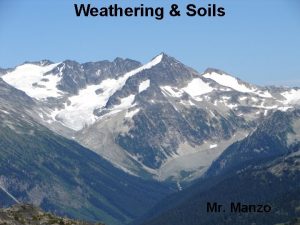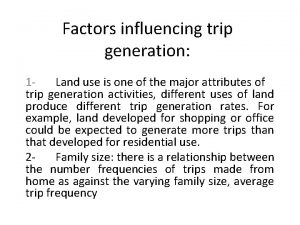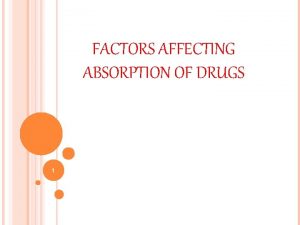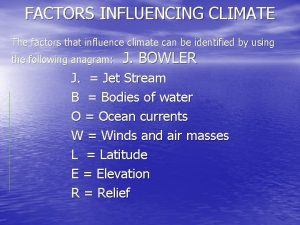Environment Types of Environment factors influencing Environment What





























- Slides: 29

Environment, Types of Environment & factors influencing Environment

What is Environment? The term environment comes from the French word “environ” and means everything that surround us. The totality of the surrounding conditions for comfortable living of organism. Environment is the area in which we live.

Why we need Environment? Environment has played very important role to make able to survive for all biotic and abiotic component in Earth. While talking about the advantages of environment, it has much more benefit. Let take the example of benefit of it, we human being are social animal as well as powerful than other animals on Earth. Good environment is good for living things same as polluted environment is very harm full to living things.

We human being need food to live, air to breath, water to drink etc. Which are getting from environment. If there is no suitable environment on the earth then it will be unable for the human to survive on earth.

Types of Environment Natural environment Manmade environment

What is Natural Environment? Natural environment is in which an organism live naturally on the earth. In other words, wildness is called Natural environment of the organisms. Wildness means the organism lives and interact with natural atmosphere such as earth, rocks and air etc.

Natural Environment The components of natural environment are air, water, soil, land, radiations, forests, wildlife, flora and fauna etc.

Manmade Environment It include transportation, housing, agricultural and livestock farms, aquatic farms, industries, dams, energy such as hydro thermal and nuclear energy plants etc.

Components of Environment 1. Abiotic components 2. Biotic components 3. Biophysical components 4. Energy components

1. Abiotic components the components which surround us but these are non living. Abiotic components are non living chemical and physical factors in the environment, which affect ecosystems. The abiotic components of an ecosystem can be listed through SWATS: Soil, Water, Air, Temperature and Sunlight.

2. Biotic Components components which surround us but includes living components. Biotic components include: a) producers b) Consumers c) Decomposers

3. Biophysical components Living and non living components both are when combined they form biophysical components. It includes all the factors that have an influence on the survival, development and evolution of organisms. For example these components form a) Marine environment b) Atmospheric c) Terrestrial environment

4. Energy components It include solar energy, geo chemical energy, thermo electrical energy, nuclear energy etc.

Common abiotic components a) Atmosphere b) water c) Air or wind d) Temperature and sunlight e) Chemical elements

Atmosphere The atmosphere of the earth is the envelop which surround us. Animals and other creatures breathe oxygen or filter it from water, and plants grow because of the presence of carbon dioxide. It protects the earth from harmful ultraviolet rays coming from sun.

Water All living organisms needs some water intake. Water covers 70% of the earth’s surface and falls as rain or snow over land. In an environment with little water, only organisms requiring a small percentage of water can survive. Other organisms thrive in conditions with large amounts of water, such as marine animals and plants in oceans. Water is essential to survival, but every organisms needs a different amount of water.

Air or Wind Often biotic factors are affected by other factors. Air or wind is consist of many gases, some of these gases are essential for living like oxygen and carbon dioxide. The wind speed and direction affects the temperature and humidity of an area. It also carries seeds and aids pollination, spreading life.

Temperature and Sunlight Temperature of the air and water affect animals, plants and human in ecosystems. A rise in temperature has the potential to change the way a living thing develops, because it changes the metabolic activites of organism. All living organisms have a tolerance level of temperature. e. g a human would die if he stood out in minus 50 degree temperature. Light exposure often affects the temperature. Areas with direct sunlight are warmer.

Chemical elements act within the environment to impact what type of organism can grow in the area. The chemical composition, including acidity level, has a large impact on the plants in an area. Chemical elements make up all matter, including other abiotic factors.

Common biotic components a) Producers (autotrophs) For example; plants b) Consumers (heterotrophs) � For example; animals c) Decomposers (detritivores) For example; micro-organisms (fungi & bacteria)

Common biophysical Environments a) Marine environment b) Terrestrial environment

Marine Environment Saline water present on the earth covers approximately 72% of planet surface. The ocean contains 97% of the earth’s water. It is the habitat of 230000 known species of animals and aquatic plants.


Terrestrial environment The environment belonging to the land as opposed to the sea or air. It include all the plants and animals grow up and develop on the surface of earth. For example: human, animals, plants, crops etc.

Factors responsible for change in Environment 1. Deforestation for wood and bringing land under cultivation this cause erosion of the soil. This activity has been going on from the past thousand of years. 2. Killing the gentle animals for food and fierce animals due to safety reasons. 3. The industrial and scientific revolution in the recent past has the tremendous affect on environment. This aspect is mainly responsible for polluting the water bodies with the chemicals from industries waste.

4. A large number of episodes have affected the environment. The most important is London smog that kill 4000 people in 1952.

Effect of insecticides on environment Insecticides can accumulated in fatty tissue of organism through plants and vegetables, which has disaster effect. The target insert develop resistance against insecticides after a period of time. The effectiveness of insecticides decreases in manufacturing industries insecticides. The workers are affected by slow poisoning affect of the insecticides.

Effect of fungicides on environment The fungicides in the soil increases number of harmful bacteria and decreases the population of useful fungi certain fungicides are toxic to soil arthropods continue use of fungicides make the pest resistance to them. Mercurial fungicides are responsible for human poisoning and death. This happen when injection of floor and wheat seed treated with Mercurial with lead to mercury poisoning.

 Personality traits meaning
Personality traits meaning Which type of weathering
Which type of weathering What is a wage
What is a wage Physical factors influencing agriculture
Physical factors influencing agriculture Factors influencing projectile trajectory
Factors influencing projectile trajectory Historical and contemporary issues in nursing
Historical and contemporary issues in nursing Factors influencing trip production
Factors influencing trip production External factors influencing pricing decisions
External factors influencing pricing decisions A model of destination image formation
A model of destination image formation Factors that influence communication
Factors that influence communication Factors influencing maternal health
Factors influencing maternal health Local factors affecting wound healing
Local factors affecting wound healing Factors influencing faculty staff relationship
Factors influencing faculty staff relationship Facility layout objectives
Facility layout objectives Supply chain network design decisions
Supply chain network design decisions Physical factors influencing agriculture
Physical factors influencing agriculture Factors affecting consensus in law
Factors affecting consensus in law Types of chemical weathering
Types of chemical weathering Distributor storage with last mile delivery
Distributor storage with last mile delivery Factors affecting oxygenation slideshare
Factors affecting oxygenation slideshare History of farming
History of farming Basic carburetor diagram
Basic carburetor diagram Factors influencing t&d
Factors influencing t&d Differentiated learning theories
Differentiated learning theories Factors influencing drug absorption
Factors influencing drug absorption Conclusion of gifted child
Conclusion of gifted child Design options for a distribution network
Design options for a distribution network Factors influencing compensation philosophy
Factors influencing compensation philosophy Disadvantage of distributor storage with carrier delivery
Disadvantage of distributor storage with carrier delivery Hanau quint
Hanau quint




















































